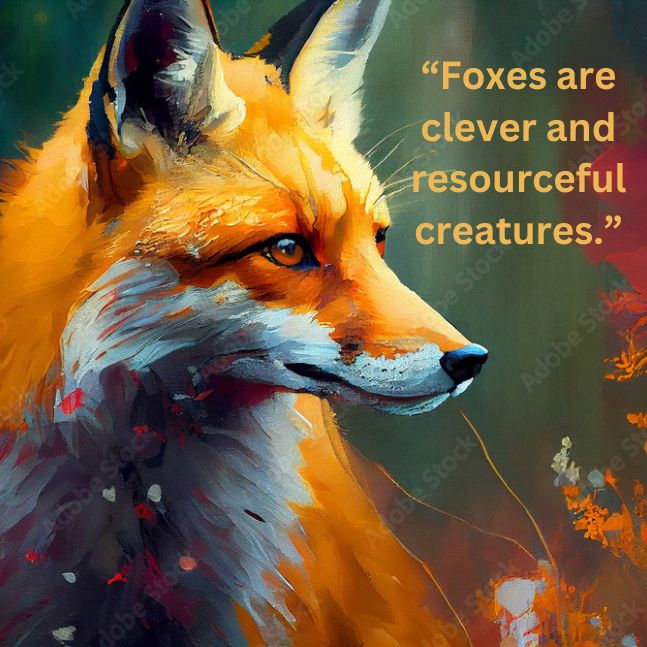
The Fox: Nature’s Adaptable and Cunning Creature
Foxes are fascinating animals known for their intelligence, adaptability, and distinctive features. Belonging to the Canidae family, which includes dogs, wolves, and other canids, the most recognized species is the red fox (Vulpes vulpes). With their cunning behavior and varied habitats, foxes have captured human imagination and have become significant in folklore, culture, and ecology.
Physical Characteristics
Foxes are medium-sized mammals, characterized by their elongated snouts, bushy tails, and large, pointed ears. The red fox, in particular, has a thick, reddish-orange coat with a white-tipped tail and black markings on its legs and ears. Adult red foxes typically weigh between 8 to 15 pounds and measure about 18 to 33 inches in length, excluding their tails, which can add an additional 12 to 18 inches.
Foxes possess keen senses that aid in their survival. Their eyesight is particularly adapted for low-light conditions, allowing them to hunt effectively at dawn and dusk. Their sense of hearing is exceptional; they can detect even the faintest sounds, such as the movements of small rodents under the snow, making them efficient hunters.
Habitat and Distribution
Foxes are remarkably adaptable and can thrive in a wide variety of environments, from forests and grasslands to urban areas and deserts. The red fox, for instance, has the most extensive range of any fox species, found across North America, Europe, Asia, and parts of North Africa. Other notable species include the Arctic fox, fennec fox, and swift fox, each adapted to their specific habitats.
In urban areas, foxes have become increasingly common, often scavenging for food in parks, gardens, and even dumpsters. Their ability to adapt to human environments demonstrates their resourcefulness and intelligence.
Behavior and Social Structure
Foxes are primarily solitary animals, although they may form small family groups, especially during the breeding season. A typical fox family consists of a mating pair and their offspring. The male, known as a dog or tod, and the female, called a vixen, will work together to raise their young.
Breeding occurs once a year, usually in late winter. After a gestation period of about 52 days, the vixen gives birth to a litter of 2 to 12 kits. The kits are born blind and helpless, relying on their mother for nourishment and protection. As they grow, both parents play roles in teaching them essential survival skills, including hunting and foraging.
Foxes are known for their playful behavior, particularly when interacting with their kits. They engage in social play, which helps develop their physical skills and social bonds. Despite their generally solitary nature, foxes communicate with each other through a range of vocalizations, body language, and scent marking.
Diet and Hunting Techniques
Foxes are omnivorous and have a diverse diet that includes small mammals, birds, insects, fruits, and vegetables. Their adaptability in diet allows them to thrive in various environments, exploiting available food sources. Red foxes, for example, may hunt rodents, rabbits, and birds, while also scavenging for food in urban settings.
Hunting techniques vary among species and individuals. Foxes are known for their cleverness in stalking prey. They often employ a “pounce” technique, leaping into the air to catch small animals hidden in grass or snow. Their keen hearing allows them to pinpoint the location of prey, enabling them to execute precise and stealthy attacks.
Ecological Role
Foxes play a vital role in maintaining ecological balance. As predators, they help control populations of small mammals, which can prevent overgrazing of vegetation. By regulating these populations, foxes contribute to the health of their ecosystems.
Additionally, foxes are scavengers, consuming carrion and leftover food, which aids in decomposition and nutrient cycling. Their foraging habits also help disperse seeds from fruits they consume, promoting plant growth in their habitats.
Cultural Significance
Throughout history, foxes have held significant roles in various cultures and mythologies. Often portrayed as cunning and clever, they appear in folklore and fables across the globe. In Western literature, the fox is frequently depicted as a trickster, showcasing its intelligence and adaptability. A famous example is Aesop’s fable, “The Fox and the Grapes,” which illustrates the concept of cognitive dissonance.
In some Indigenous cultures, the fox symbolizes adaptability and resourcefulness. It is often seen as a guide, leading individuals through challenges with its cleverness. Conversely, in other cultures, foxes may be viewed with suspicion or as symbols of deceit.
Conservation Status
While many fox species are abundant and widespread, some face threats due to habitat loss, hunting, and climate change. The Arctic fox, for instance, is particularly vulnerable due to its dependence on cold habitats, which are rapidly disappearing due to global warming.
Conservation efforts are essential to protect fox populations and their habitats. Organizations work to create protected areas, promote responsible land use, and educate communities about the importance of coexistence with wildlife. Supporting biodiversity is crucial for maintaining healthy ecosystems, where foxes play an integral part.
Conclusion
The fox is a remarkable creature embodying adaptability, intelligence, and resilience. Its ability to thrive in diverse environments and its role in ecological balance highlight its significance in nature. Beyond their biological importance, foxes have captivated human imagination, symbolizing cunning and resourcefulness in cultures worldwide.
As we continue to navigate the challenges of habitat loss and environmental change, understanding and protecting foxes and their habitats becomes increasingly crucial. By fostering coexistence and appreciation for these intelligent animals, we can ensure that future generations will also marvel at the cunning and grace of the fox.















